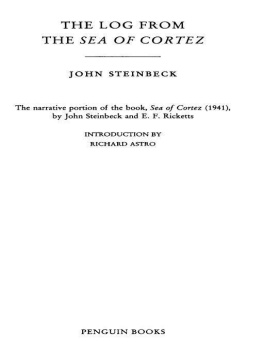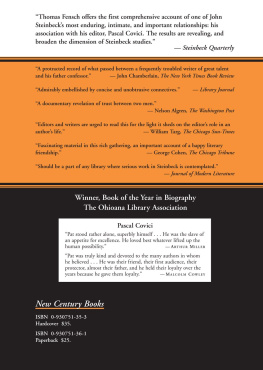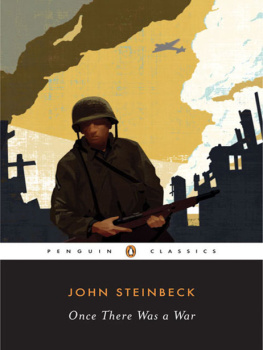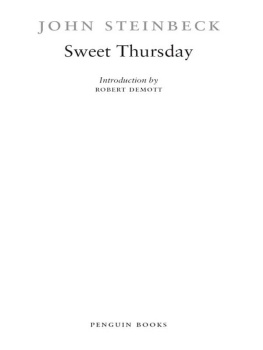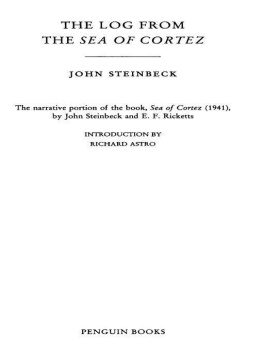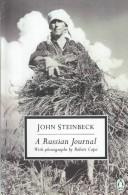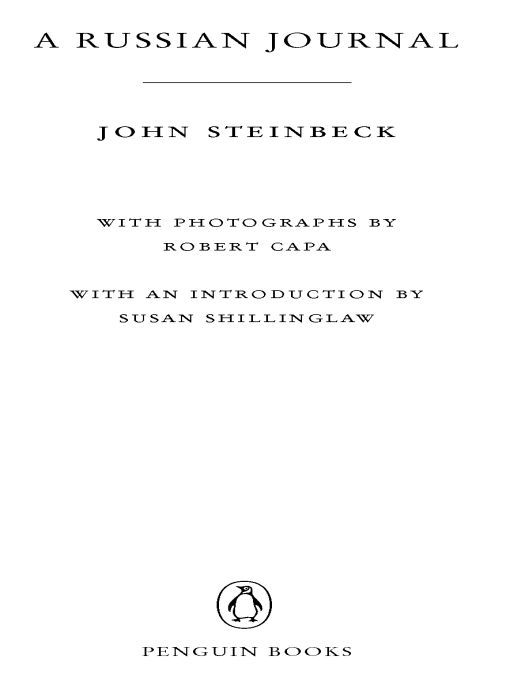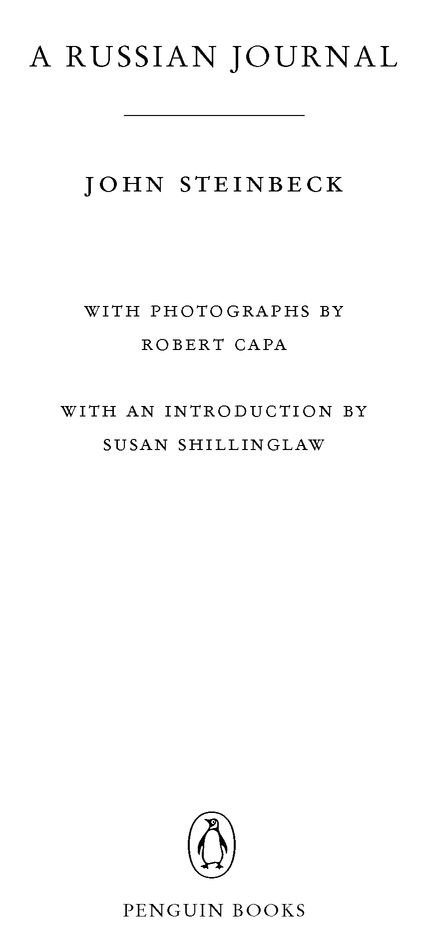Table of Contents
PENGUIN TWENTIETH-CENTURY CLASSICS
A RUSSIAN JOURNAL
Born in Salinas, California, in 1902, John Steinbeck grew up in a fertile agricultural valley about twenty-five miles from the Pacific Coastand both valley and coast would serve as settings for some of his best fiction. In 1919, he went to Stanford University, where he intermittently enrolled in literature and writing courses until he left in 1925 without taking a degree. During the next five years, he supported himself briefly as a laborer and journalist in New York City and then as a caretaker for a Lake Tahoe estate, all the time working on his first novel, Cup of Gold (1929). After marriage and a move to Pacific Grove, he published two California fictions, The Pastures of Heaven (1932) and To a God Unknown (1933), and worked on short stories later collected in The Long Valley (1938). Popular success and financial security came only with Tortilla Flat (1935), stories about Montereys paisanos. A ceaseless experimenter throughout his career, Steinbeck changed courses regularly. Three powerful novels of the late 1930s focused on the California laboring class: In Dubious Battle (1936), Of Mice and Men (1937), and the book considered by many his finest, The Grapes of Wrath (1939). Early in the 1940s, Steinbeck became a filmmaker with The Forgotten Village (1941) and a serious student of marine biology with Sea of Cortez (1941). He devoted his services to the war, writing Bombs Away (1942) and the controversial play-novelette The Moon Is Down (1942). Cannery Row (1945), The Wayward Bus (1947), The Pearl (1947), A Russian Journal (1948), another experimental drama, Burning Bright (1950), and The Log from the Sea of Cortez (1951) preceded publication of the monumental East of Eden (1952), an ambitious saga of the Salinas Valley and his own familys history. The last decades of his life were spent in New York City and Sag Harbor with his third wife, with whom he traveled widely. Later books include Sweet Thursday (1954), The Short Reign of Pippin IV: A Fabrication (1957), Once There Was a War (1958), The Winter of Our Discontent (1961), Travels with Charley in Search of America (1962), America and Americans (1966), and the posthumously published Journal of a Novel: The East of Eden Letters (1969), Viva Zapata! (1975), The Acts of King Arthur and His Noble Knights (1976), and Working Days: The Journals of The Grapes of Wrath (1989). He died in 1968, having won a Nobel Prize in 1962.
Born Endre Erno Friedmann in Budapest, Hungary, on October 22, 1913, the self-styled Robert Capa became one of the most celebrated war photojournalists of the twentieth century. He left Hungary at seventeen, and until he died, in 1954killed by a land mine in Indochinahe roamed the world photographing war. With his beloved companion, photographer Gerda Taro (killed in 1937), he first saw action during the Spanish Civil War, where his empathetic portraits of human anguish won him international acclaim. In 1938 he traveled to China and witnessed the Japanese invasion; he covered World War II, Israel in 1948, and Indochina in 1954. During his life he published five photographic texts: Death in the Making (photographs by Robert Capa and Gerda Taro, 1938); The Battle of Waterloo Road (text by Diana Forbes-Robertson and photographs by Capa, 1941); Slightly Out of Focus (1947); A Russian Journal (1948); and Report on Israel (text by Irving Shaw and photographs by Capa).
Susan Shillinglaw is a professor of English and director of the Center for Steinbeck Studies at San Jose State University. She co-edited Steinbeck and the Environment and John Steinbeck: Contemporary Reviews. She edits The Steinbeck Newsletter and has published articles on Steinbeck.
INTRODUCTION
IN 1946, WINSTON CHURCHILL announced that an Iron Curtain had been drawn closed across Eastern Europe. In the winter of 1947, the cold war began in earnest. The Soviet Union, fierce ally of the United States in World War II, had become a menacing presence, a foe barely understood. In the papers every day, John Steinbeck begins his text, there were thousands of words about Russia, and yet, he continues, there were some things that nobody wrote about Russia, and these were the things that interested us most of all. His quest, and that of photographer Robert Capa who accompanied him, was to discover the great other side, the private life of the Russian people. Steinbeck and Capas modest book about the lives of Russians, A Russian Journal, published in 1948, attempts only honest reporting, to set down what we saw and heard without editorial comment, without drawing conclusions about things we didnt know sufficiently.
In many ways, that is what John Steinbeck had been doing quite successfully for twenty years, writing books about ordinary people: paisanos, Oklahoma migrants, enlisted men in World War II, Mexican peasants. A Russian Journal does not sound the epic chords of The Grapes of Wrath, certainly, but it has some of that books empathy and humanity. Indeed, one explanation for the appeal of A Russian Journal is that this book, unlike so many other accounts of Russia published at the time, engages and informs in Steinbecks most characteristic manner: expressing empathy and understanding for working people; capturing with a journalists eye the telling detail; seeing nonteleologically, recording merely what is witnessed; and finally leavening the narrative with a wry humor absent in many more ponderous contemporary accounts of travel through Soviet-approved locales. If not the most erudite or wide-ranging book about postwar Russia, Steinbeck and Capas is just what they claimed for it: It is not the Russian story, but simply a Russian story.
The collaboration between Capa and Steinbeck was, in fact, serendipitous. The two had met in London in 1943, and renewed their friendship in New York in March 1947, planning to leave for Russia as soon as possible, until, on May 14, Steinbeck took a nasty fall from a window of his apartment, shattered his knee, and spent a few weeks recovering (the knee, however, would give him problems throughout the trip). Each restless and independent, neither Capa nor Steinbeck, in fact, particularly cared for collaborative ventures. As early as 1936, when writer John OHara passed through Pacific Grove, eager to meet and then work with John Steinbeck on a stage adaptation of the recently published In Dubious Battle, Steinbeck declared that he liked him and his attitude.... I think we could get along well. I do not believe in collaboration. Yet despite his protest to the contrary, collaboration came easily to Steinbeck; he initiated or was drawn into several joint projects, many completedas was his 1940 trip to the Sea of Cortez with marine biologist Edward Ricketts (Sea of Cortez, 1941)some aborted, as was the one with OHara. In particular, Steinbeck gravitated toward visual artists, filmmakers, and photographers. Robert Capa, famed war photojournalist, formed with Steinbeck perhaps the happiest of Steinbecks alliances with an artist in another medium.
Capa, whose celebrated war photos had frozen individual human torment and exuberance, shared Steinbecks compassion and curiosity. Born in Budapest, Hungary, in 1913, Capa possessed the qualities of exuberance, tolerance, and a humanitarian spirit that captivated Steinbeck. As biographer Richard Whelan notes, Capas political philosophy, similar to Steinbecks own, was formed when Capa was a rebellious teen: democratic, egalitarian, pacifistic, semi-collectivist, pro-labor, anti-authoritarian, and anti-fascist, with a strong emphasis on the dignity of man and the rights of the individual. Forced to leave Budapest in 1931, he had been in exile most of his life, wandering the world as witness to the ravages of war, sometimes shooting photos for


